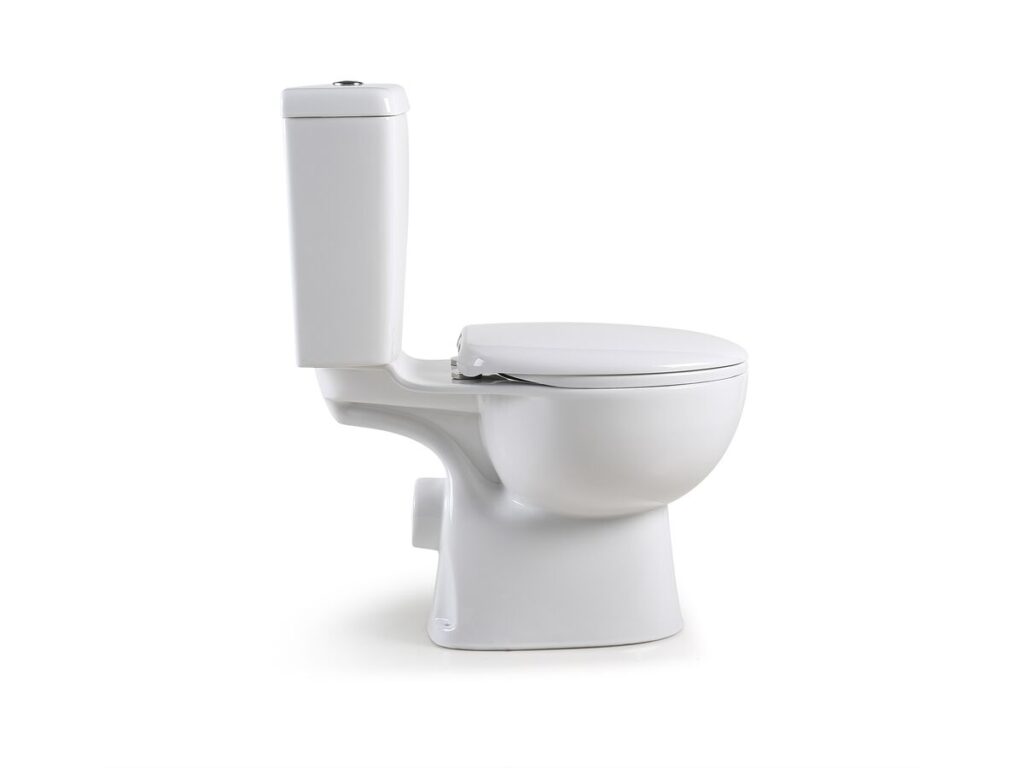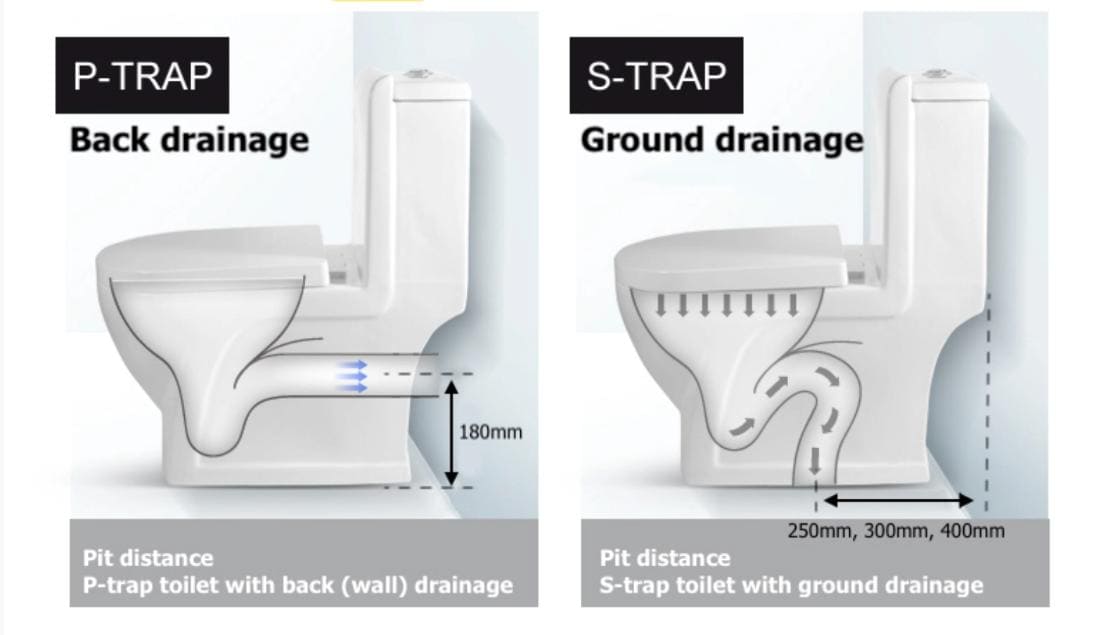Toilet traps are highly significant in the functioning of a toilet. Installing a toilet with an efficient trap system is often recommended to avoid sewer gases. These traps can be either S or P shapes, determining specific working. To select between P-trap and S-trap toilets, you must consider certain factors. This article covers a comprehensive guide on toilet traps to help you choose the most reliable one.

What is a Toilet Trap?
A toilet trap is an essential plumbing component present in the drainage system of a toilet. The trap blocks sewer gases using a U-shaped or S-shaped bend in the drainpipe. They retain a small amount of water within the curve. You must know the toilet trap types before selecting between p-trap and s-trap toilets.
What are P-Trap Toilet Bowls?
A P-trap toilet has a P-shaped pipe that keeps water in the bottom. It results in a barrier that prevents sewer gases from entering the drain. In a bathroom, the P-trap is built into the toilet bowl itself. That part of the toilet curves down and connects to the sewer pipe or drainage system.

Specifications of P-Trap Toilet Bowl:
| Product | Mode P-Trap Toilet Bowl |
| Height | 400mm |
| Depth | 540mm |
| Trap | P-Trap |
| Standard | Watermark Approved |
| Inclusions | Toilet Pan |
What are S-Trap Toilet Bowls:
S-Trap consists of a curved pipe that goes downward, forms an S shape, and then connects to the drainage system. S-traps are less common today and do not apply in modern plumbing installations. S-traps have been replaced mainly because P-traps are more effective. They excel at preventing sewer gas from escaping and are less prone to siphonage issues.
Specifications of S-Trap Toilet Bowl:
| Product Name | S-Trap Power Flushing Toilet Bowl |
| Size | 690x360x810 mm |
| Flushing | Siphonic Double Flushing |
| Water Sense | 1.28 GPF |
| MAP | 1000G |
| Trap-way | Skirted |
| Shape | Elongated Bowl Shape |
| Seat Cover | Quiet-Close PP Seat Cover |
Working of S-Trap Toilets:
When you flush an S-trap toilet, the wastewater and waste inside the bowl flushes down the drain. The wastewater and waste exit the toilet bowl and flow into the drainpipe.
The unique feature of an S-trap toilet is its S-shaped bend in the drainpipe. An S-trap toilet has a curved, S-shaped section of the drainpipe. The S-trap dips below the floor level and then curves back up before connecting to the sewer or drainage system.
The S-trap contains water in its bottom curve. This water blocks sewer gases and odors from traveling back up through the drainpipe and into the toilet. The water in the S-trap acts as a barrier to keep these gases contained in the sewer or drainage system.
S-trap toilets also require a ventilation system to prevent water siphonage from the S-trap. It maintains proper drainage and allows air into the pipes to prevent airlock. The vent system is essential for the effective functioning of the toilet.
Working of P-Trap Toilets:

When you flush a P-Trap toilet, the water and waste inside the bowl are pushed down the drainpipe. As the wastewater and waste travel down the drainpipe, they encounter the P-trap. It is usually built into the toilet or lies below it. This shape of the trap gives it the name “P-trap.” The P-trap contains water in its bottom curve. This water prevents sewer gases and odors from traveling back up through the drainpipe and into the toilet or the bathroom.
In addition to the P-trap, the toilet plumbing system has a ventilation system. Ventilation is essential to prevent the siphoning of water from the P-trap. Its absence could break the seal and let sewer gases enter the living space. The vent system allows air into the pipes, preventing airlock and enabling smooth wastewater flow. This is how a p-trap toilet works

Design Advantage – P-Trap vs. S-trap Toilets.
The trap in the p-type bowl has no overloops or bending structure. This trap’s exit is downwards with a horizontal path at its base. This horizontal trap way takes the water for a turn of 90 degrees and then downwards. The water has to travel a little longer in this trap, which is more common than the looping traps. The best part about the P-Trap toilet design is that it can handle large amounts of water.
On the other hand, the design of the strap toilet is straightforward and basic. The drainpipe at the toilet’s base emerges and connects with a traditional trap way. Similarly, the drain enters the trap from moving under the sink. This type has a drawback over the former one. If one throws waste other than human waste in a bowl, it can cause a blockage of the drain.

Desirable Setup _ P-Trap vs. S-Trap Toilets.
Elevated buildings and top floors are the most desirable Setup for a p-trap toilet bowl. It is recommended that users who have a residency on top of buildings install a p-trap toilet bowl. The reason is their design and construction. Always consult a professional for upright installation of the toilet bowl.
The ground floor is the best setting for installing a s-trap toilet bowl. The trap design complies with the ground floor requirements and eases the process for desirable performance.
Backflow Prevention _ P-Trap vs. S-Trap Toilets.
The sealing mechanism of the sealing element at the bottom of the trap does backflow prevention in p-trap toilets. The central part prevents sewer gases or waste backflow in the bowl. The water may flow through the overflow pipe but not enter the toilet bowl. Thus, we can say that p-trap toilets have a resilient natural seal that blocks backflow.
The backflow prevention in s-traps is equipped with air filters. These air filters remove the foul odor by carrying them into the drain pipe. It also prevents waste from backflowing in the toilet. However, the backflow prevention of the s-trap is not as efficient as that of the p-trap.
Efficiency: P-Trap vs. S-Trap Toilets.
P-Trap toilets work efficiently under varying conditions. They can handle tons of water and provide a straightforward waste disposal method. They are durable and perform for a relatively longer period.
S-Trap toilets are less efficient due to their setback of drying out. These traps can cause discomfort due to foul odor, leading to gas flow. These toilet traps are difficult to clean, and any malfunction can cost the replacement of the whole S-trap.
Water Conservation: P-Trap vs. S-Trap Toilets.
The drain pipe in p-traps has the shape of the letter P. This design leads to reserving water on flushing through these pipes. Wastewater stays temporarily in the p-trap; thus, it takes less water to flush waste into the sewer drain. Therefore, we can term p-trap as a water-saving element of the toilets.
The s-shaped design of the trap reserves the wastewater in the drain. It, thus, requires sufficient water to remove waste from the toilet. These traps are less favorable due to low water conservation and flushing mechanisms.
General Differences Between P-Trap and S-Trap Toilets:
Here are some general differences between P-Trap and S-Trap toilets.
| Property | P-Trap Toilet | S-Trap Toilet | |||
| Trap Shape | P-shaped curve in the drainpipe. | S-shaped bend in the drainpipe. | |||
| Space Requirements | It needs more room behind the toilet bowl. | There needs to be more space behind the toilet bowl. | |||
| Modern Plumbing Codes | Generally, in compliance with current plumbing codes and standards. | It may only meet modern plumbing code standards in some regions. | |||
| Availability and Commonality | Widely available and used in contemporary construction. | Becoming less common in modern construction. |
P-Trap vs S-Trap: Which One is Best?
The best between P-trap and S-trap toilets depends on the usage requirements. P-trap bathrooms are generally considered the better option due to their superior odor control. To select between P-trap and S-trap toilets, always think about their working and functional adaptability. They offer reduced siphonage risk, compliance with modern codes, and proven performance. S-Traps are ruling out of the industry due to certain limitations. Therefore, we can conclude that p-trap is the best choice.
Applications of S-Trap and P-Trap Toilets:
S-Trap.
- S-trap toilets are common in older buildings constructed before modern plumbing standards. These toilets may still be used in such structures for historical reasons.
- S-trap toilets are used in some areas or countries due to variations in plumbing standards and practices. They are becoming rare in modern construction.
- S-trap toilets still apply in portable toilet installations at construction sites or outdoor events.
P-Trap:
- P-trap toilets are the more applicable type in residential bathrooms. They are well-suited for typical household use.
- Many offices, restaurants, and hotels also use P-trap toilets in their restroom facilities. These toilets suit high-traffic areas and provide efficient, odor-free waste disposal.
- P-trap toilets are often mandated in regions with current plumbing codes and regulations. They have superior performance and reduced risk of odor issues. They are the standard for most plumbing installations.

Conclusion:
By now, you can select between s-trap and p-trap toilets. Always go for a toilet trap supplier with reliable B2B solutions and customer care. In comparison between P-Trap and S-Trap, both have specific properties. P-Traps being more convenient and efficient are the choice of the majority. At the same time, S-Traps can be suitable in some conditions while inappropriate in others.
Trap specifications can be critical when selecting between P-trap and S-trap toilets. It helps filter out the irrelevant listings and gives you an idealistic description of what your product should look like. Yet, the selection of traps depends upon their usage and buyer demand.

